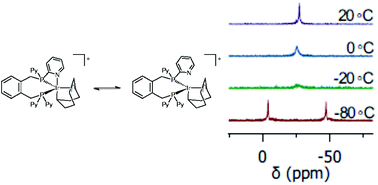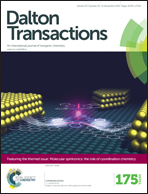Transition metal complexes of the pyridylphosphine ligand o-C6H4(CH2PPy2)2†
Abstract
The synthesis and coordination behaviour of the pyridylphosphine ligand o-C6H4(CH2PPy2)2 (Py = 2-pyridyl) are reported. The phosphine selenide was synthesised and the 1JPSe value of 738 Hz indicates the phosphorus atoms have a similar basicity to PPh3. The ligand reacts with platinum(II) and palladium(II) complexes to give simple diphosphine complexes of the type [MX2(PP)] (M = Pt, X = Cl, I, Me, Et; M = Pd, X = Cl, Me). When the ligand is reacted with chloromethyl(hexa-1,5-diene)platinum the [PtClMe(PP)] complex results, from which a series of unsymmetrical platinum complexes of the type [PtMeL(PP)]+ (L = PPh3, PTA, SEt2 and pyridine) can be made. This enabled the comparison of the cis and trans influences of a range of ligands. The following cis influence series was compiled based on 31P NMR data of these complexes: Py ≈ Cl > SEt2 > PTA > PPh3. Reaction of [PtClMe(PP)] with NaCH(SO2CF3)2 and carbon monoxide slowly formed an acyl complex, where the CO had inserted in the Pt–Me bond. Attempts to achieve P,P,N chelation, through abstracting the chloride ligand in [PtClMe(PP)], were unsuccessful. When the ligand reacted with platinum(0), palladium(0) and silver(I) complexes the bis-chelated complexes [M(PP)2] (M = Pt, Pd) and [Ag(PP)2]+ were formed respectively. Reaction of the ligand with [Ir(COD)(μ-Cl)]2 formed [IrCl(PP)(COD)]. When the chloride ligand was abstracted, the pyridyl nitrogens were able to interact with the iridium centre facilitating the isomerisation of the 1,2,5,6-η4-COD ligand to a 1-κ-4,5,6-η3-C8H12 ligand. The X-ray crystal structure of [Ir(1-κ-4,5,6-η3-C8H12)(PPN)]BPh4 confirmed the P,P,N chelation mode of the ligand. In solution, this complex displayed hemilabile behaviour, with the pyridyl nitrogens exchanging at a rate faster than the NMR time scale at room temperature.


 Please wait while we load your content...
Please wait while we load your content...